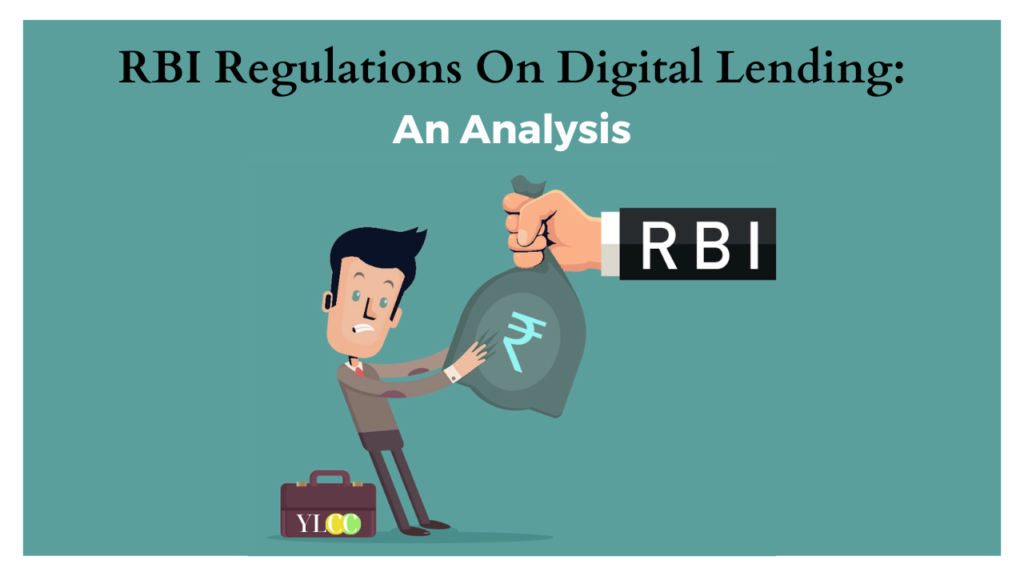

With the advent of Financial Technology, otherwise commonly knows an FinTech, the banking and lending sector has undergone tremendous changes. In fact, the digitalisation of the banking space, registration of NBFCs (Non-Banking Financial Companies) as well as Digital Payment platforms has been immensely helpful for crores of Indians who otherwise found it difficult to access quality services in this area. For several years, this space has gone unregulated for the most part. However, this has given rise to a number of issues. A recent report by the Reserve Bank of India (RBI) indicated that as of February 2021, 600 out of 1,100 lending apps operational in India are illegal. It is because of such reasons that RBI has now assumed a more proactive role in identifying issues with and regulating the digital lending sector.
This article is aimed at exploring and analysing the latest regulations on digital lending as notified by the Reserve Bank of India. Read on!
WHICH ENTITIES HAVE TO FOLLOW THESE NEW RBI GUIDELINES?
To make regulation easier, the Reserve Bank of India has divided digital lenders into the following categories:
- Organizations coming under RBI regulations and are entitled to carry out lending business
- Organizations not regulated by RBI but are entitled to lend as per regulatory or statutory provisions
- Organizations that lend beyond the domains of regulatory or statutory stipulations
The regulations that have been explained hereafter are primarily applicable to the first category of authorised lenders. The organisations coming within the purview of the first category are also called Regulated Entities (REs) or Lending Service Providers (LSPs).
THE PRESS RELEASE BY RBI
For the sake of understanding the information better, the notification maybe divided into 3 parts:
- Annex I, which contains the recommendations accepted for immediate implementation;
- Annex II, which contains the recommendations which are accepted in-principle, but require further examination; and nodal grievance redressal officers are easily available on the websites of the regulated entity and can be helpful in assessing you with any complaint about the digital lending product
- Annex III which contains the recommendations which require wider engagement with the Government of India and other stakeholders in view of complexities involved in their implementation.
Now let us understand the highlights of the new regulations.
- Enhancing Compliance Models
While the details on how this is to be implemented is yet to be discussed and decided, the Regulations state that REs shall ensure that financial products involving contractual agreement, in which a third party guarantees to compensate up to a certain percentage of default in a loan portfolio of the RE, shall adhere to Master Direction – Reserve Bank of India (Securitisation of Standard Assets) Directions, 2021 dated September 24, 2021.
Furthermore, suggestions have been made of a self-regulatory organisation which is proposed to be set up for the digital lending industry which would have some degree of autonomy as well as responsibility over prescribing model agreements for such entities, codes of conduct, training and accreditation mechanisms, blacklists of entities which violate norms and framing of standardised code of conduct for recovery actions, among other things. REs are also required to ensure that any lending done through DLAs has to be reported to Credit Information Companies (CICs), irrespective of its nature or tenor. More importantly, lending through the Buy Now Pay Later (BNPL) model also needs to be reported to the CICs.
- Furnishing Comprehensive Information
A standardized Key Fact Statement must be provided to the borrower before executing the loan agreement. This shall include a cooling-off/ look-up period during which the borrowers can exit digital loans by paying the principal and the proportionate APR without any penalty shall be provided as part of the loan contract. However, the Press Release has not stipulated the number of days for the cooling-off period.
- Establishing A Customer Grievance Redressal Policy
REs and LSPs employ recovery agents who have often been reported to employ unscrupulous means to recover the pending amounts. The RBI has also specifically regulated the area of recovery agents, considering this has been a huge cause of consumer grievances in the past.
Furthermore, for many digital lending applications, there was no option in the application or otherwise to redress any grievances of a borrower which previously led to massive inconveniences on their part. However, the RBI notification has mandated making Nodal grievance redressal officers easily available on the websites of the regulated entity so that they can be helpful in assessing the borrower with any complaint about the digital lending product. Furthermore, it has also been provided that if the complaint isn’t resolved within 30 days by the RE, a complaint can be filed under the Reserve Bank – Integrated Ombudsman Scheme.
- Protecting Consumer Data
The Press Release given by the RBI give ample priority to the data privacy issues of consumers. It adds a layer of complexity and compliance over and above the existing framework provided by the Information Technology Act, 2000 making it a lot more stringent. The REs are required to store all data in servers located within India. Further, any data collected by DLAs must be need-based, must be with the prior and explicit consent of the borrower, and further require that data is not retained for longer than is necessary as disclosed to the customer. The central bank has also mandated that DLAs should not access mobile phone resources, such as files and media, such as files and media, contact list, call logs, and telephone functions. However, one-time access can be taken to the camera, microphone, or any other facility necessary for onboarding new customers/ KYC verification requirements with the explicit consent of the borrower.
- Prioritising The Customer
Under the new regulations, the RE cannot increase the credit limit until and unless clear consent is given by you. In addition to this, for all types of costs, REs are required to ensure that all inclusive costs for the digital loans are required to be disclosed to the borrowers upfront. It also specified that digital lending entities and not the borrowers should pay fees or charges payable to Lending Service Providers (LSPs) in the credit intermediation process.
GUIDELINES FOR BORROWERS TO KEEP IN MIND
With the emergence of a large number of digital lenders, it is important to be careful of who you are borrowing from. Here are some important practices that consumers can keep in mind for a safer borrowing-lending experience:
- Before borrowing even the smallest of amounts, first check if the lending organisation is registered with the RBI. If it is not, this is a red flag and you must stay away from such organisations.
- Understanding the Annual Percentage Rate (APR) or Monthly Percentage Rate (MPR) is very important before borrowing any amount.
- Do look over the Key Fact statement before availing of a loan. Key Facts Statement (KFS) summarizes key information of the loan you are interested in and can be used for comparison purposes between different credit.
- If you find it ideal, you must not leave the opportunity to lay off a loan within the look-up period.
- Do not give digital lenders unfettered access to your personal info if you do not feel it is right or if you do not understand the purpose of the information.
- It is important to make sure that borrowing is not affecting your credit score.
With these comprehensive regulations for digital platforms, more informed and smarter decisions could be made about getting digital credit. Furthermore, these new RBI recommendations can play a significant role in curbing and preventing digital lending scams and frauds by fraudsters. It would encourage due diligence on the part of working NBFCs or banks. Further, these safeguarding tools will connect legitimate digital lenders to the customers for quality services with hassle-free and affordable experience.
YLCC would like to thank its Content Team for their valuable insights in this article.




